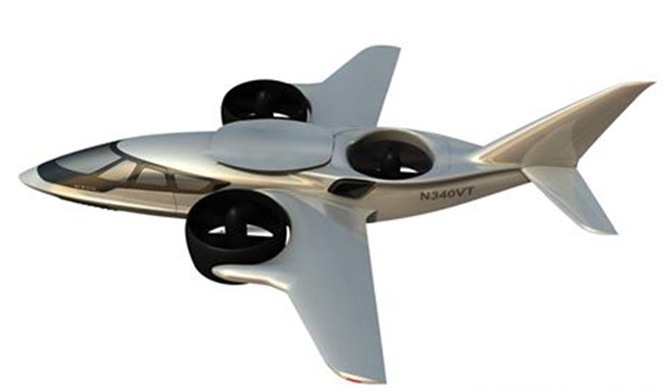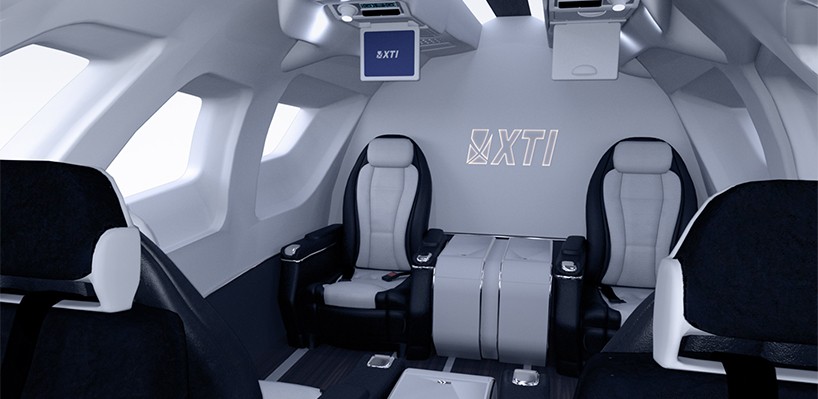Aerospace
6 seater Jet with Vertical take off..!!

SEPTEMBER, 1ST 2015 Various urban air transport aircraft have been proposed in recent years, and none of them works very well due to the complexities of working in an urban environment. The XTI Aircraft, an American company, based in Colorado wants to change it all. They have recently launched an ambitious Kickstarter campaign to fund the production of a new urban transport jet that can take off like a helicopter.
The total money required by the company is just 50 million dollars and the maximum amount of money raised by any project at Kickstarter is 20 million dollars. So it will have to be quite a campaign to raise that kind of funding. The plane can carry around six passengers and fly as fast as regular business jets nowadays. The obvious target market is the business community. It would be even harder to get the kind of funds they need because this community is always skeptical of these of these ideas and investing in them through crowdfunding.
XTI VTOL aircraft2

How Does it works ?
Using three ducted fans, the TriFan 600 lifts off vertically and in seconds the two wing fans rotate forward for a seamless transition to high-speed flight. Within just 90 seconds, the airplane reaches cruise speed – where the lift is provided by the wings just like every other fixed-wing airplane. The fuselage-mounted fan, no longer needed, closes up. The airplane flies directly to its destination and reverses the process. Landing vertically right where it needs to be – wherever there’s a clear helipad-sized paved surface.
The Facts
- MAX CRUISE SPEED ~340 kts (400mph)
- MAX CRUISE ALTITUDE – Over 30,000 feet above predominant weather
- RANGE- 800 – 1,200 miles*
- VERTICAL LIFT – 3 ducted fans
- ENGINE UP – 2,600 shaft horsepower range
- FLIGHT CONTROL- Fly-by-wire
- TIME TO MAX ALTITUDE – 11 minutes
- TIME TO MAX CRUISE SPEED – 90 seconds
We have seen this type of aerospace designs in many movies like the Avatar so, it doesn’t surprise many from the outside, but it should. It is very difficult to come up with an actual working model. The thrust is provided by three ducted fans, one in the tail, and other two on the wings. The wing fans can rotate 90 degrees to enable high-speed flight once the aircraft is good to go. It has been Named Tri-fan 600 for this arrangement.

Back view
According to XTI, the concept arose soon after the formation in 2009. David Brody, ex-Ceo of AVX Aircraft Co. was at the forefront of the whole process. Soon enough he was able to gather more influential people in the industry to work for his cause. The company has high hopes of achieving its target despite the odds against their project. They are of the opinion that aviation leaders will all come forward to make this aircraft a reality as they are branding it as a “kitty hawk” moment for the business transportation.
XTI VTOL aircraft
Tri-Fan if it becomes reality is going to be the first long-range, high-speed Vertical Take-off, and Landing commercial aircraft. It can fly as fast as business jets, but it can also land with ease on any helipad sized surfaces. It has a seamless transition from vertical to normal flight, and this might be the most significant achievement of the company. This tech has faced several problems over the years including the famous F-35 fighter project. The company also claims a maximum speed of 400 mph and a maximum range of 1000-1200 miles.
The aircraft would be further developed over the course of next two years with particular focus given to existing proven technologies. Several financing milestones lie in the process of its fulfillment and XTI is hopeful they will resolve them soon enough.
Liked It?
Share With your Friends and Family

Aerospace
Which is bigger 777x or 787 aircraft ?

The 777X is a new series of the Boeing 777 family and is designed to be larger and more efficient than its predecessor. It features two variants: the 777-8 and the 777-9, being the larger of the two.
The Boeing 777X emerges as the larger sibling within the Boeing family, representing a significant leap forward in both size and efficiency. Comprising two variants, the 777-8 and the 777-9, the latter takes the crown as the larger of the two. With its expansive fuselage and impressive wingspan, the 777X is tailored for long-range journeys and boasts a substantial passenger capacity.
On the other hand, the Boeing 787, affectionately known as the Dreamliner, occupies a niche in the market as a smaller yet formidable aircraft designed for medium to long-range flights. Its distinguishing feature lies in its composite fuselage, a technological marvel that renders it lighter and more fuel-efficient compared to conventional aluminum counterparts. The Boeing 777X is larger than the Boeing 787 aircraft.
When it comes to passenger capacity, the 777-9 reigns supreme, typically accommodating a sizeable contingent of 400-425 passengers in its standard configuration. In contrast, the 787, with its more modest dimensions, typically carries between 240-290 passengers, depending on the variant and layout.
One of the remarkable innovations introduced with the 777X is its folding wingtips, a feature designed to address the logistical challenges of accommodating such a large aircraft in conventional airport gates. These folding wingtips enable the 777X to retract its wings, allowing it to fit into gates designed for smaller aircraft while still reaping the benefits of an extended wingspan during flight, thereby enhancing fuel efficiency and operational flexibility
Aerospace
China Secures Production Certificate for Mass Production of Pilotless eVTOL Aircraft

The first passenger-carrying pilotless electric vertical takeoff and landing (eVTOL) aircraft in the world, the EH216-S, has received the Production Certificate for its eVTOL aircraft from the Civil Aviation Administration of China (CAAC).
This is a significant milestone for EHang Holdings Limited, the leading UAM technology platform company in the world. This outstanding accomplishment is another big step towards mass manufacturing for the eVTOL aircraft and the ensuing commercial operations, building on the ground-breaking acquisition of the Type Certificate and the Standard Airworthiness Certificate for the EH216-S.
The PC is a crucial certificate that the aircraft maker receives from the CAAC, the country’s aviation authority. By obtaining this certificate, EHang has demonstrated that it has set up a quality management system for mass production that satisfies the airworthiness regulation standards set forth by the CAAC, and the company has been given permission to continue producing mass quantities.
It is also a strong guarantee of the calibre of the goods made by EHang. Raw materials, supplier management, manufacturing organisation, production quality control, aircraft pre-delivery test, after-sales repair and maintenance, etc. are all included in the mass production quality management system for the EH216-S.
To ensure that every aircraft and its components that roll off the production line strictly adhere to the approved type design and safety requirements, the system sets clear guidelines and documentation for every step in the production procedure. This ensures comprehensive traceability and safety control.
Aerospace
Four Airbus A380 Superjumbos lined up to be scrapped

In a strategic move aimed at reclaiming valuable resources from the iconic Airbus A380 aircraft, VAS Aero Services and Dr. Peters Group have announced a significant collaboration.
This partnership marks a milestone in aviation logistics and aftermarket services, with four of these colossal planes slated for teardown and redistribution of used serviceable material (USM).
The venture between VAS Aero Services, renowned for its expertise in aircraft dismantlement, and Dr. Peters Group, a prominent Germany-based investment fund management firm, underscores a commitment to sustainable aviation practices. This isn’t their first foray into scrapping A380s; their successful partnership has already seen the dismantlement of these aircraft, making them pioneers in this niche.
Under the agreement, the latest consignment brings the tally to eight A380s entrusted to VAS by Dr. Peters Group. Managing Director Christian Mailly of Dr. Peters Group emphasized the trust placed in VAS, citing their unparalleled capabilities in dismantlement and aftermarket sales network. It’s a strategic move in response to the growing demand for quality USM parts, particularly with the resurgence in reliance on the A380.
Notably, the teardown process will be carried out at various locations, optimizing the positioning of harvested parts to cater to different markets. While some parts will be positioned in Europe to support operators in the region and the Middle East, others will remain in the Asia-Pacific region. This meticulous strategy ensures efficient access to spare parts, benefiting MROs and airlines across these markets.
The decision to retire these A380s comes at a time when operators are reassessing fleet strategies amidst evolving market dynamics. Despite initial plans for quick retirement due to the emergence of more fuel-efficient alternatives, factors such as a rebound in long-haul demand and delays in new widebody deliveries have prompted operators to reconsider. The A380, with its unique capacity and capabilities, presents a practical solution for short-term capacity management.





















